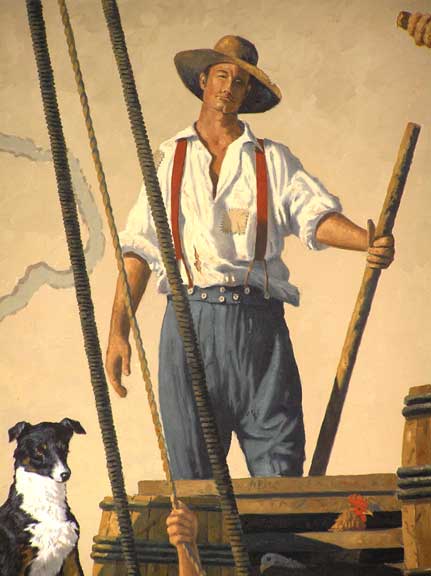

I have fallen behind with my updates the past few months. After all, it is summer; and, summer is my river time. I have finished the left side of the mural. Progress is going well.

As I said, summer is my river time. Time to research new ideas and to work on my river studio The River Rover. Above, I am on a research trip up the Illinois River. Sandy went along. Her main job was deck hand and fixing a meal or two so that I could keep my strength up in order to paint and sketch. She also read her favorite books along the way. Note the deer antlers on the roof of the River Rover. The fastest steamboat on the river in the 1800's was given the honor of displaying a set of deer or elk antlers in front of the pilot house. The River Rover may not be the fastest boat on the river; but, she's not the slowest either. If you push her, twenty-seven to twenty-eight miles per hour with a little left. Not bad for a 1971 houseboat. She does have new motors though.

The work that I have started aboard the River Rover is entitled: Inland Waterways: The Rivers of Imagination. The work will be a study of the river today, its people, and environment. I plan to paint on board the River Rover as above and in a plein air format, on location. The works will be small and more impressionistic, a good thing after the mural. It is great to be able to start and finish a painting in a short period of time. The studio boat has also provided me with an opporturnity to get away from the large mural to collect my thoughts. However, I am still able to be productive.


In the upper left-hand corner, you will find an image representative of the Native American heritage of the river, mainly the Mississippian culture. The river for them was a lifeline of trade from the far reaches of the West, the East, the Great Lakes, and the Gulf of Mexico.


The other figures in this area are devoted to the flatboat/keelboat era. The figures are depicting the four methods of propelling a keelboat. The figure above represents the process of poling the boat by planting the pole in the river shallows and pulling the boat forward. Note that this area is superimposed over a 1797 map of the Mississippi River.




And, a fourth method of propulsion was cordelling, a process of taking a long rope, tying it to the bow of the keelboat and pulling from the bank. A keelboat on a good day could travel twelve to fifteen miles upstream.

Another important job on the keelboat was the job of patroon. Or, the steersman controlling the boat from the stearn and also shouting orders to the other crew members. Thus, the boat made way as a team effort.

Of course the most important member of the crew is our black and white dog named Snookie. She is my favorite model; and she always get top billing.

Now that summer is drawing to a close, it is time to return to the studio to finish the job at hand. Thank you for visiting the Mural Journal.
All the best to you,
